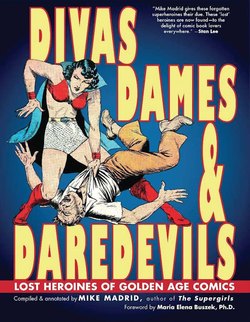Читать книгу Divas, Dames & Daredevils - Mike Madrid - Страница 8
На сайте Литреса книга снята с продажи.
ОглавлениеA CAST OF THOUSANDS
Imagine you are in a present-day comic book shop. Take a glance over the shelves of comic books and you’re likely to see many familiar titles—Superman, Batman, The Incredible Hulk, Wonder Woman, Spider-Man, Fantastic Four, Iron Man, Catwoman, and X-Men. These are all the names and faces and colorful costumes that we’ve come to expect to see on comic book shelves for decades.
Now imagine you’re looking at a similar rack of comic books from 70 years ago. First off, there were no specialty comic book shops then—those didn’t appear in America in great numbers until the 1970s. So if these were the 1940s, you’d be looking at comics at a newsstand, a drug store or a candy shop. And the assortment of titles would look different from what we’re used to seeing—Champion Comics, Crackajack Funnies, Hit Comics, Heroic Comics, Wings Comics, Planet Comics, Military Comics, Jungle Comics, Wonderworld Comics, All-American Comics, Thrilling Comics, Air Fighters Comics. These were anthology titles, and they were the mainstay of the comic book industry from the late 1930s to the mid ’50s—the era that has come to be known as the Golden Age of comic books.
The comic book industry in great part grew out of pulp magazines. Pulps offered cheap, often titillating fiction. Whether it was detective stories, science fiction or horror tales, fantasies or westerns, each issue featured work by different writers. After Superman made his 1938 debut, comic books became the hot ticket on the newsstand. Pulp magazine publishers began switching formats from written stories to illustrated stories, still using the same formula of presenting several different stories per issue.
The anthology concept made sense in the early days of comics, when publishers were trying to figure out what would attract readers to the fledgling medium. Rather than bank on the appeal of a single character, publishers would offer readers an assortment of stories in each anthology title. Very few of these stories continued from issue to issue. Most were self-contained, and were told in few pages, sometimes six or less. This was a new medium, and writers knew their readers had no prior history with these characters. So the writing was tight and well–handled. The reader was taken on a journey filled with action, danger, plot twists, and some humor, all wrapped up in less than ten pages.
Since superheroes were such an exciting new concept, most of the anthology titles had a popular crime-fighting hero as their headliner. So, Superman starred in Action Comics, Batman in Detective Comics, and Captain Marvel in Whiz Comics. The characters featured in the rest of the issue could have been another superhero or two, a detective, perhaps a tuxedo-clad sorcerer, a dashing soldier of fortune or a science fiction hero. A humor or “funny animal” feature usually rounded out the issue. These comics were forty-two, fifty-two, sixty-four or more pages for a dime—a fantastic variety show in every issue. If any of these features proved to be unpopular with readers, the publisher could simply replace it with a new one. And if any heroes proved to be very popular, like Superman or Batman, they could be spun off into their own titles.
